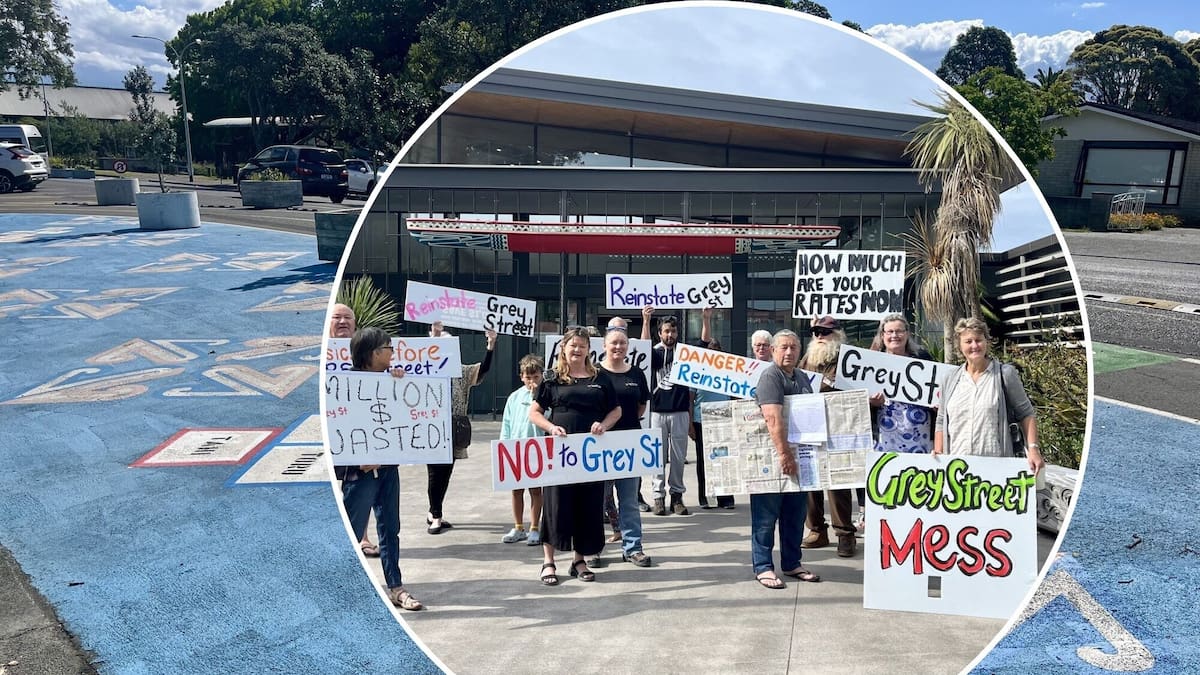The Streets for People trial design was aimed at calming traffic and encouraging walking and cycling between the city centre, Waikanae Beach and Alfred Cox Park.
But it sparked weekly protests from residents, with accusations the council had not listened to ratepayers and the changes had made the street too narrow and unsafe.
An independent review, by Urban Connections Ltd, considered community feedback, as well as a technical review and site observations, which informed the four options to be presented to councillors.
“The trial achieved lower vehicle speeds and improved pedestrian crossing safety,” according to the review.
However, it also identified issues with accessibility, maintenance and cycling usability.
Surface deterioration, missing tactile guidance and inconsistent markings also affected the street corridor, the report said.
The four options councillors will deliberate on Wednesday are:
Option 1 – “Do Nothing”: This carries an ongoing maintenance cost of $18,000 per year and road marking costs of $45,000, if the council were to continue with the “bespoke painting elements”, according to the meeting’s report.
As the council receives NZ Transport Agency (NZTA) funding of 68c for every $1 spent through a financial assistance rate, the council estimates NZTA would fund $42,840, with rates funding of $20,200.
Option 2 – “Full Reversal”: Restoring the pre-trial layout.
According to the meeting’s report, this option could cost a total of $110,000, with NZTA funding of $74,800 and rates funding of $35,200.
Option 3 – “Pedestrian-Priority”: Retain the pedestrian facilities, such as the crossings and speed-management features, but remove the cycleway.
This option could cost a total of $77,000, with NZTA funding of $52,360 and rates funding of $24,600.
Option 4 – “Pedestrian and Cyclist Shared Path”: This would keep the pedestrian and safety aspects of the trial, however, it would also reinstate car parks and create a shared facility for pedestrians and cyclists.
This option could cost up to $215,000, with NZTA funding of $146,200 and rates funding of $68,800.
All options required detailed design and cost estimation. The indicative costs were compared at a high level only, the report said.
The project was delivered in partnership between the council and Tairāwhiti Adventure Trust.
Of the street’s total cost of $756,256, 90% was contributed by NZTA and 10% came from the council.
An additional $35,000 was spent to return the Grey St and Kahutia intersection to its former state, following a report that found “unintended” safety issues in November 2024.
“Staff have asked for additional support to fund for full or partial reversal costs at the original financial assistance rate from NZTA at 90%.
“The rationale being as major investors and stakeholders to the project, they should be accountable for reversal costs. This report is also a condition of the original funding agreement.”
However, according to the report, NZTA replied that there was no funding available because of a changing direction of the Government Policy Statement for Land Transport.
“This resulted in a reprioritisation of funding from walking and cycling and safety projects (like road to zero) projects into resilience projects.
“Therefore, if Council choose Option 4, it will have to fully fund the footpath cost of $138,000,” the meeting’s report says.
The measure of success for Grey St was to make the area from Childers Rd to just past the skatepark “more vibrant, fun, and improve safety for all road users on different modes of transport”.
However, community consultation between August 2024 and October 2025 showed that out of 1116 responses received, 89% of respondents said the street design had not met its objective, 7% said it had and 4% responded with “somewhat”.
According to the review, 71% of comments were negative in tone, 19% mixed, 6% positive and 4% neutral.
“While many submitters acknowledge positives such as lower traffic speeds, safer crossings and a more people-focused intent, these are often expressed alongside strong concerns about parking loss, heavy vehicle access, layout clarity and ongoing maintenance, leading most respondents to oppose retaining the layout in its current form,” the review says.
Councillors will deliberate on the four options at Wednesday’s council meeting.
They will provide direction to council staff on a preferred option or hybrid of the options tabled, and advise on whether further analysis or engagement is required.

